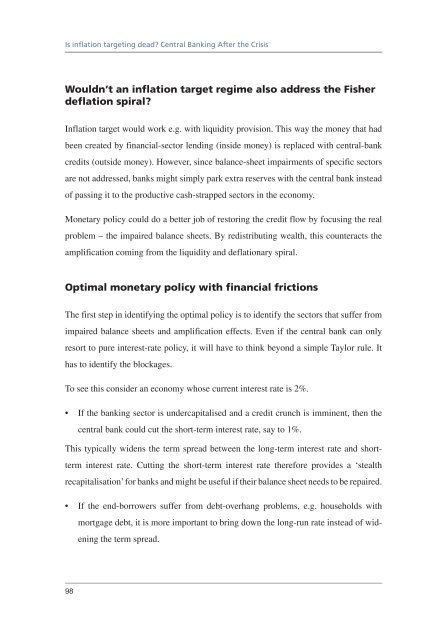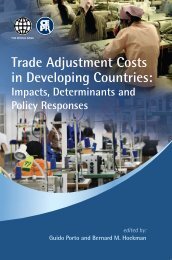Is inflation targeting dead? Central Banking After the Crisis - Vox
Is inflation targeting dead? Central Banking After the Crisis - Vox
Is inflation targeting dead? Central Banking After the Crisis - Vox
You also want an ePaper? Increase the reach of your titles
YUMPU automatically turns print PDFs into web optimized ePapers that Google loves.
<strong>Is</strong> <strong>inflation</strong> <strong>targeting</strong> <strong>dead</strong>? <strong>Central</strong> <strong>Banking</strong> <strong>After</strong> <strong>the</strong> <strong>Crisis</strong>Wouldn’t an <strong>inflation</strong> target regime also address <strong>the</strong> Fisherdeflation spiral?Inflation target would work e.g. with liquidity provision. This way <strong>the</strong> money that hadbeen created by financial-sector lending (inside money) is replaced with central-bankcredits (outside money). However, since balance-sheet impairments of specific sectorsare not addressed, banks might simply park extra reserves with <strong>the</strong> central bank insteadof passing it to <strong>the</strong> productive cash-strapped sectors in <strong>the</strong> economy.Monetary policy could do a better job of restoring <strong>the</strong> credit flow by focusing <strong>the</strong> realproblem – <strong>the</strong> impaired balance sheets. By redistributing wealth, this counteracts <strong>the</strong>amplification coming from <strong>the</strong> liquidity and deflationary spiral.Optimal monetary policy with financial frictionsThe first step in identifying <strong>the</strong> optimal policy is to identify <strong>the</strong> sectors that suffer fromimpaired balance sheets and amplification effects. Even if <strong>the</strong> central bank can onlyresort to pure interest-rate policy, it will have to think beyond a simple Taylor rule. Ithas to identify <strong>the</strong> blockages.To see this consider an economy whose current interest rate is 2%.• If <strong>the</strong> banking sector is undercapitalised and a credit crunch is imminent, <strong>the</strong>n <strong>the</strong>central bank could cut <strong>the</strong> short-term interest rate, say to 1%.This typically widens <strong>the</strong> term spread between <strong>the</strong> long-term interest rate and shortterminterest rate. Cutting <strong>the</strong> short-term interest rate <strong>the</strong>refore provides a ‘stealthrecapitalisation’ for banks and might be useful if <strong>the</strong>ir balance sheet needs to be repaired.• If <strong>the</strong> end-borrowers suffer from debt-overhang problems, e.g. households withmortgage debt, it is more important to bring down <strong>the</strong> long-run rate instead of widening<strong>the</strong> term spread.98














